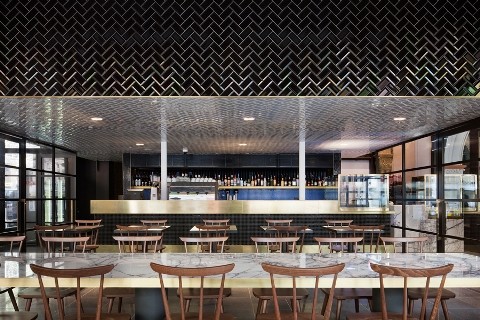Kirsten Stanisich, director of SJB Interiors, originally grew up in Melbourne where she studied and worked for SJB Architects and then SJB Interiors.
She relocated to Sydney in 1999 and has been the designer behind some of the city's best known bars and restaurants, including Tank Stream Bar, Hugo's Bar Pizza, Middle Bar Darlinghurst, The Bank Hotel, Will + Toby's Manly and Sepia restaurant.
Architecture & Design spoke to Stanisich about why colour is important, Sydney’s bar identity and how she is trying to create an identity in Sydney’s small bars.
 Hugo's Bar Pizza. Image: SJB Interiors
Hugo's Bar Pizza. Image: SJB Interiors
How would you compare the design of small bars in Sydney to Melbourne?
Right now, I think we’re seeing a lot of similarity in the design of small bars in both cities. The look is quite heavy and grounded and there seems to be two strong design approaches. The first being an industrial approach with quirky vintage furniture, face brickwork, exposed services, raw or black metal work, concrete and glazed tiles which has been around for quite a while now.
The second is taking a more themed approach where operators are being a bit more literal in creating an interior which relates directly to their offer, like Mexican or American. I think a lot of this has been driven by the tight design fees and construction budgets that are needed to make a small bar stack up from a business point of view.
What type of ‘bar identity’ do you think Sydney should have?
I think it would be great to see Sydney become a bit more confident with its own bar identity. Creating diversity between the cities will help to foster new design ideas which ultimately makes design more interesting. The Vivid festival was a great example of how the context of Sydney can be used to create an incredible experience which relies on the uniqueness of our city - re-creating the event in Melbourne would lead to a very different experience.
It would be great to see more colour, more experimentation and some lightness to the detailing come through in our bar designs as well as some reference to the local context.
How do you attempt to recreate this identity in your designs?
Right now we are exploring a more polished and decorative style of design. We’re looking for contemporary elements in our furniture and finishes rather than a vintage ‘found’ feel.
What small bar in Sydney do you admire for its design?
I used to love the bar at the back of Lotus which was designed by HPG. It was beautifully detailed and there was a perfect sense of sophisticated intimacy.
What are the three most important things when it comes to the interior design of small bars?
Getting the planning, acoustics and lighting right are probably the most fundamental things but creating the aesthetic gives the venue its personality.
How did growing up in Melbourne shape your approach to architecture?
The small bar license legislation was passed in Melbourne while I was at university, so that had a huge effect on how I went out with my friends. It influenced my thinking on creating small intimate spaces which were all about conversation.
Before that, nightclubs were huge - not just popular but massive in their scale and also in the budgets the operators spent fitting them out. There was a nightclub called Inflation which was designed in a Memphis style by Built Modern, a young architectural practice, which included Dale Jones Evans. I hadn’t seen anything like it before. In a nightclub environment, which is all about the visual rather than conversation, it showed me how interiors can really affect this experience.
What is the best piece of advice anyone has ever told you?
Andrew Parr, one of my business partners gave me some great advice on how not to be scared of using of colour. He said that if you know how to make colour work when you’re dressing, apply the same thinking to colour in an interior, which basically meant don’t let your thinking get so uptight it stifles any creative experimentation.

